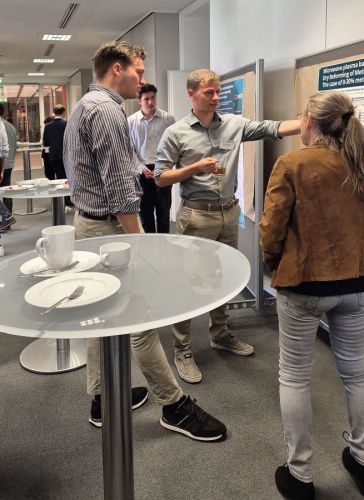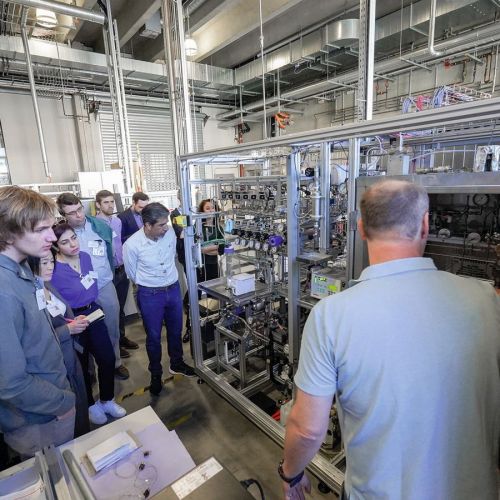International workshop of the European Research Association for Thin Films (EFDS) in Marl on the further development of plasma technologies and catalysts for the chemical industry
The international workshop "Plasma, Catalysis and Thin Films for Conversion Processes" took place in Marl at the end of April. Almost 60 experts from ten countries engaged in intensive discussions on how to develop catalysts that actively catalyze chemical reactions in plasma. They are driving forward numerous development approaches, particularly in the context of the electrification of the chemical industry and energy-efficient process design, in order to achieve innovative and economic progress.
Several networks are working together on this topic. The European Research Association for Thin Films, together with Plasma Germany, the User Group for Atmospheric Pressure Plasma (Ak-adp) and the German Catalysis Society (GeCatS), coordinated an internationally acclaimed event. It brought together renowned experts from both fields. An international program committee, consisting of representatives from the Institute of Chemistry at the University of Antwerp, the Institute of Interfacial Process Engineering and Plasma Technology at the University of Stuttgart and the Leibniz Institute for Plasma Science and Technology e. V., jointly prepared the program.
Electrification of chemical catalysis through plasma technology
The event began with in-depth insights into the fundamentals of gas conversion. Renowned experts analyzed the effect of catalysts, integrated the design of processes and reactors into their considerations and analyzed the influence of plasmas on the respective reactions. Current example processes illustrated the topic.
The focus was on three central example systems: Firstly, experts analyzed ammonia as an energy source and transport medium for hydrogen. They showed how plasma technologies can support the synthesis of ammonia from hydrogen and nitrogen. Secondly, they focused on methane pyrolysis, which can be used to produce green hydrogen and high-quality carbon products. Thirdly, they concentrated on the generation of nitrous gases, which are necessary for the production of chemical products such as nitric acid or ammonia. In addition, they used plasma as a tool to break down pollutants such as nitrogen oxides and PFAS residues and researched its effectiveness in this area.
Plasma as the key to increasing energy efficiency
 Plasma technologies are increasingly seen as the key to increasing energy efficiency in electrified processes and open up exciting prospects for industry. Their ability to generate highly reactive species that require less activation energy for chemical reactions holds enormous potential. As a result, processes can run at lower temperatures - which saves energy - chemical equilibria can be shifted in favor of desired products or the selectivity of reactions can be specifically improved.
Plasma technologies are increasingly seen as the key to increasing energy efficiency in electrified processes and open up exciting prospects for industry. Their ability to generate highly reactive species that require less activation energy for chemical reactions holds enormous potential. As a result, processes can run at lower temperatures - which saves energy - chemical equilibria can be shifted in favor of desired products or the selectivity of reactions can be specifically improved.
However, the interaction between plasma and catalysts also poses challenges. The reactive species generated by the plasma can impair the functionality of existing catalysts by initiating new molecular mechanisms on the surfaces or shifting the process window into unfavorable areas. This has put the development of innovative, plasma-compatible catalysts at the center of the discussion.
These new catalysts must not only harmonize with the reactive species in the plasma, but also have a high selectivity and work under optimal process conditions. The challenge is to develop materials that are both stable and flexible enough to meet the complex requirements of plasma catalysis.
Another focus was on the design of modern reactor geometries. These must provide sufficient space for the plasma to form effectively, while the active species are generated close enough to the catalyst to react chemically prior to their relaxation. Direct interactions between plasma and catalyst bed offer great advantages here, as they enable short diffusion paths. At the same time, the limited size of the gaps between catalyst particles and carrier materials requires a rethink of the structure and porosity of the catalysts.
The combination of tailor-made catalysts and innovative reactor designs could pave the way for a revolutionary optimization of electrified processes - efficient, sustainable and with a groundbreaking impact on the chemical industry.
New innovative processes for an efficient chemical industry
Process engineers are challenged to fundamentally rethink chemical processes. Innovative approaches are opening up opportunities to make entire synthesis routes more efficient using alternative reactions. It is particularly exciting to consider the subsequent processing of reaction products, which often causes considerable energy consumption in the overall process. If new reaction pathways allow simpler and less energy-intensive preparation, the entire process could become more efficient - even if the actual reaction step initially appears more complex.
Another exciting approach concerns the flexibility of chemical processes. Traditional processes often require continuous operation, as stopping and starting could damage the catalysts. New process designs could make the decisive difference here: they enable greater adaptability so that processes can be started or stopped as required. This flexibility allows chemical reactions to be optimally adapted to fluctuations in energy prices or electricity grid utilization, for example during energy peaks or low-cost electricity phases.
Such innovations have the potential to make the chemical industry not only more energy-efficient, but also more dynamic and resilient to external influences. A paradigm shift that promises both ecological and economic benefits. From the industry's perspective, the ability to scale processes and consider energy efficiency plays an important role in the development. The economy must work economically and cannot afford to waste energy. Process redesign cannot just be for electrification. The investments must bring an economically viable advantage in order to build a sustainably functioning industry.
Outlook for innovation through research and development
 Overall, the experts agreed that every process requires its own individual solutions. Scientists are currently still working very intensively on the fundamental understanding of how reactions take place on the catalyst surface. Only through a mechanistic understanding of the reactions can efficient reactors be developed and favorable synthesis routes defined.
Overall, the experts agreed that every process requires its own individual solutions. Scientists are currently still working very intensively on the fundamental understanding of how reactions take place on the catalyst surface. Only through a mechanistic understanding of the reactions can efficient reactors be developed and favorable synthesis routes defined.
Numerous new approaches and collaborations have emerged from the inspiring discussions. The program was rounded off with two visits to Evonik's Marl site and the Fraunhofer Institute for Environmental, Safety and Energy Technology UMSICHT in Duisburg.
During the interactive discussion, the participants were able to ask numerous questions and gain interesting insights into the facilities. The participants also used the panel discussion at the end of the event for numerous questions and discussions in a collegial and inspiring atmosphere.
The next opportunity to discuss this exciting topic in depth will be at V2025, which will take place in Dresden from October 13 to 16, 2025. This renowned event attracts over 500 vacuum and plasma surface technology professionals every two years and combines an international conference with an impressive industry exhibition.
The latest developments and applications will be presented over three days full of innovations. October 16 in particular will be dedicated to plasma technologies in gas conversion and offers a unique platform for technical discussions and networking.
Stakeholders from science and industry are cordially invited to actively participate: Posters on relevant topics can still be submitted until August 31.


